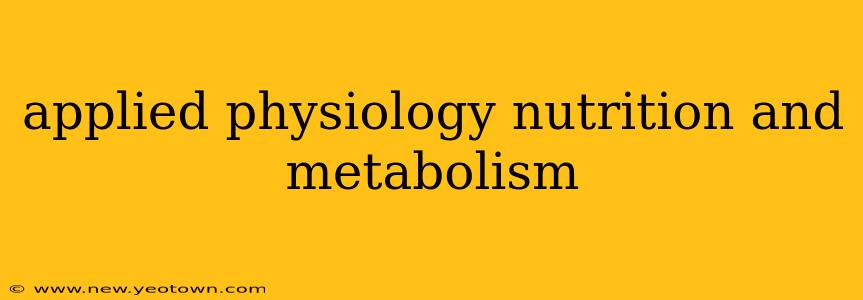The human body is a remarkable machine, a complex interplay of systems working in concert to maintain life and support our activities. Understanding this intricate relationship between applied physiology, nutrition, and metabolism is crucial for optimizing health, performance, and well-being. This isn't just about abstract scientific concepts; it's about understanding how the food we eat fuels our bodies, how our bodies respond to exercise, and how we can fine-tune this incredible system for optimal function.
Let's embark on a journey to explore this fascinating intersection, delving into the core principles that govern our physical existence.
What is Applied Physiology?
Applied physiology takes the fundamental principles of physiology – the study of how the body works – and applies them to real-world scenarios. Imagine it as the bridge connecting theoretical knowledge to practical applications. It's about understanding how the body responds to exercise, stress, altitude, and disease, and using that knowledge to improve athletic performance, rehabilitation strategies, and overall health. This field is incredibly diverse, touching upon areas like exercise physiology, sports medicine, and occupational health.
Think of a marathon runner. Applied physiology helps us understand how their cardiovascular system adapts to prolonged endurance, how their muscles utilize energy, and how their body regulates temperature during the race. It's not just about the race itself; it informs training strategies, nutrition plans, and injury prevention.
How Does Nutrition Influence Metabolism?
Metabolism is the sum of all the chemical processes that occur within our bodies. It encompasses everything from breaking down food for energy (catabolism) to building and repairing tissues (anabolism). Nutrition plays a pivotal role in this intricate process, providing the essential building blocks and fuel for metabolic reactions.
The macronutrients – carbohydrates, proteins, and fats – each have distinct metabolic pathways and contribute differently to energy production. Carbohydrates are the body's preferred fuel source for high-intensity activities, while fats are crucial for prolonged endurance and overall metabolic health. Proteins are essential for building and repairing tissues, playing a key role in muscle growth and recovery.
Micronutrients, such as vitamins and minerals, act as co-factors in numerous metabolic reactions, ensuring efficient enzyme function and overall metabolic efficiency. A deficiency in essential micronutrients can significantly impair metabolic processes, leading to various health problems.
What are the Key Metabolic Pathways?
Understanding the key metabolic pathways is crucial to grasping how our bodies utilize energy. Let's briefly touch upon some of the most important ones:
- Glycolysis: The breakdown of glucose (sugar) to produce ATP (energy).
- Beta-oxidation: The breakdown of fatty acids to produce ATP.
- Krebs Cycle (Citric Acid Cycle): A central pathway in cellular respiration, connecting carbohydrate and fat metabolism.
- Electron Transport Chain: The final stage of cellular respiration, generating the majority of ATP.
- Gluconeogenesis: The synthesis of glucose from non-carbohydrate sources, like amino acids and glycerol.
These pathways are intricately interconnected, adapting to the body's energy needs and the availability of different fuel sources.
How Does Exercise Affect Metabolism and Physiology?
Exercise profoundly impacts both metabolism and physiology, triggering a cascade of adaptive responses within the body. Regular physical activity enhances insulin sensitivity, improving glucose regulation and reducing the risk of type 2 diabetes. It stimulates mitochondrial biogenesis, increasing the number of energy-producing powerhouses within our cells. Furthermore, exercise boosts metabolic rate, leading to increased calorie expenditure even at rest.
Different types of exercise elicit distinct metabolic responses. High-intensity interval training (HIIT) can significantly improve insulin sensitivity and cardiovascular fitness, while endurance training enhances mitochondrial capacity and fat oxidation. Strength training increases muscle mass, leading to a higher resting metabolic rate.
What is the Relationship Between Nutrition and Exercise Performance?
The link between nutrition and exercise performance is undeniable. Proper nutrition fuels muscle contractions, replenishes glycogen stores (muscle's energy reserve), and supports muscle repair and growth after exercise. Consuming adequate carbohydrates before, during, and after exercise is crucial for maintaining energy levels and optimizing performance. Protein intake is equally important for muscle protein synthesis and recovery.
The timing of nutrient intake relative to exercise also plays a significant role. Consuming carbohydrates before exercise provides immediate energy, while consuming protein and carbohydrates after exercise promotes muscle recovery and growth.
What are Some Common Metabolic Disorders?
Several common metabolic disorders can significantly impact an individual's health and well-being. These include:
- Type 2 Diabetes: Characterized by insulin resistance and impaired glucose regulation.
- Obesity: A complex metabolic disorder involving excessive accumulation of body fat.
- Metabolic Syndrome: A cluster of metabolic abnormalities, including obesity, high blood pressure, and insulin resistance, increasing the risk of cardiovascular disease.
- Fatty Liver Disease: Accumulation of fat in the liver, often associated with obesity and metabolic syndrome.
Understanding the underlying metabolic mechanisms of these disorders is critical for developing effective prevention and treatment strategies.
Conclusion: A Holistic Approach to Health
Applied physiology, nutrition, and metabolism are interwoven disciplines that profoundly influence our health and well-being. By understanding these complex interactions, we can make informed choices about our lifestyle, diet, and exercise habits to optimize our physical performance, enhance our health, and improve our overall quality of life. This isn't just about achieving fitness goals; it's about understanding the remarkable machinery that is the human body and living a healthier, more fulfilling life.

